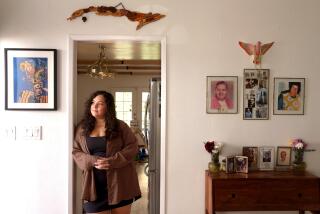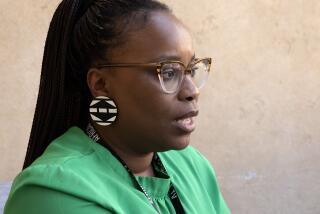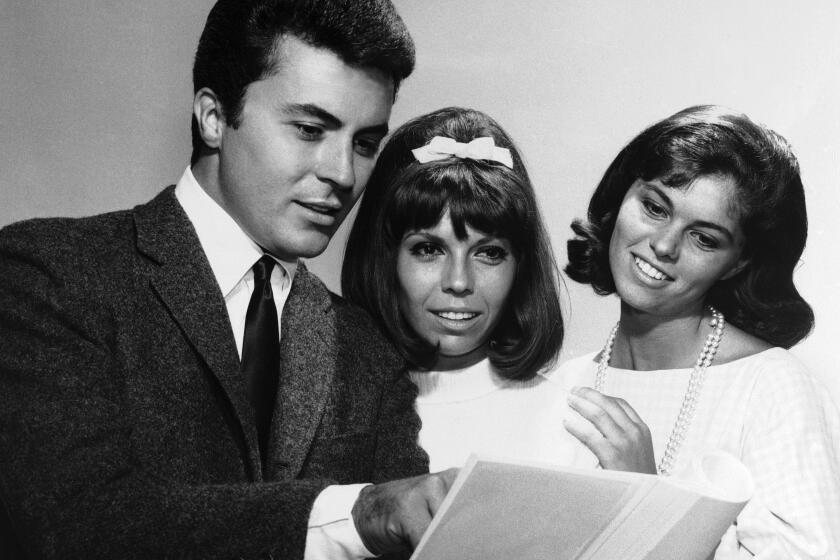More freshmen in film shooting for NYU
For the fabled young dreamer who wanted to get into the movies, there was one direction to go and that was west. Now there are even more kids dreaming the dream, attending summer film schools, editing homemade movies with sophisticated computer equipment and applying to undergraduate film programs. But sometimes the tide flows in the opposite direction; sometimes even those born in the cradle of filmmaking are heading east.
When she was a high school senior, Hannelore Williams didn’t even bother to complete the application to New York University’s Tisch School of the Arts film program. She wanted the gold standard and applied to USC. Growing up in Culver City, the former home of MGM and current home of Sony Corp.’s Columbia Pictures, she was determined to stay where the action was, which happened to be her own backyard.
But after a year there, Williams transferred to Tisch. “At NYU,” she says, “I had the chance to make my own films right away and at the same time experience the world. I mean, where better to do that but in New York?”
Now in her senior year, Williams has made several documentaries and shorts and interned at “Sex and the City,” with the Scott Rudin company and at ThinkFilm in New York.
Still, her father, a color timer in postproduction at the studios, asks the question that you can’t help wondering: Why would a kid from Tinsel Town go all the way to the other side of the rainbow to learn how to make movies?
Some of the draw is simply New York. Film students, cameras in hand, are known around campus for throwing themselves at this perfect location for someone who wants to breathe and taste all things urban and artsy.
The film school is located in a big building on lower Broadway in Greenwich Village, and one professor in a “Sights and Sounds” class had her students walk to nearby Chelsea to view dozens of works in galleries before she handed out cameras.
The Tisch staff embraces what it calls the “auteur theory” of helping each student develop his or her voice -- as if training flutists or painters or a generation of young Jack Kerouacs who would (and probably will) starve for their films. At the school’s roots are such directors as Martin Scorsese, Spike Lee and Oliver Stone, who came out of NYU more concerned with trying to get their visions on screen than with conventions of the movie business.
But the staff is also clear that it’s not trying to train one kind of filmmaker and that a fair share of the students come to Tisch more eager to learn about making blockbusters than art house fare.
New York has much to teach, whether it’s how to secure a police permit to film on a city street or how to hail a cab on a stormy day or how to find a hip club in the far reaches of boroughs. This fall there was even a 10-part reality show, “Film School,” about Tisch that aired (where else?) on the Independent Film Channel. The characters were graduate students and, of course, the city itself.
Stronghold challenger
Williams came to NYU for a lot of the same reasons that are driving 1,200 high school seniors to apply for 240 slots in fall’s freshman film class at Tisch. About half the slots are already filled with early-decision candidates, and the rest will be decided by early April. Last year about 40 of those slots went to kids from the West Coast.
Which is not to say that there is an exodus going on: USC and other premier film schools in the L.A. area are still flooded with applicants. But there’s also no denying that Tisch has established a stronghold in what has been for a long time a Southern California monopoly. Tisch consistently shares first place with USC in the U.S. News & World Report ranking of film schools.
Applicants to the film and TV program at Tisch have to clear two hurdles. First is the creative portfolio. In addition to writing an essay, they must submit 10 minutes of film, 10 photographs, 10 pages of a screenplay, storyboards or photos of paintings or sculptures. Next is the academic review. The students who make the final cut usually have at least a 3.8 grade-point average and an SAT score of 1,350, according to admission officers.
“You have to have the academic chops to cut it,” says David Irving, chairman of NYU’s undergraduate film and television program. “But a kid with a 1,500 SAT and 4.0 won’t get in if he doesn’t have the portfolio that says, ‘I know this is a difficult process, filmmaking, and I am tenacious. I have things to say.’ ”
He advises faculty on the portfolio review committee to look closely at the work because he knows the difficulty of comparing an advantaged high school senior who can find $5,000 to make a video short in a summer program with a senior who only has the resources to take 10 pictures of an ashtray. He also tells them to pay particular attention to the essays.
“I’m reading for storytelling skills, the ability to create mystery, twists, turns, all the movie languages,” says Irving. “You read a lot of material that is ‘Alias’ or ‘Alien’ in a different form, an imitation the student assumes we want. Not!”
Sharon Badal, a Tisch graduate and a former Orion Pictures vice president who has been teaching at Tisch for 10 years, has reviewed about 100 portfolios for the fall. An essay she read by a student who thought she was too cool to take her younger sister to an ice show impressed Badal because it was poignant and vivid.
“Most of the professors think of ourselves as artists, not as producers, directors or cinematographers,” she says. “We want kids who we can encourage to also march to their own drum.”
Like USC, NYU has had a film program since the early part of the 20th century but only developed a separate school in 1965, seeking to become an incubator for film mavericks. Years later, the beat goes on with such indie and mainstream filmmakers as Jim Jarmusch, Martin Brest, Todd Solondz, Brett Ratner, Ang Lee, Amy Heckerling and Wes Anderson.
Outside the mainstream
The city is by definition on the fringes of the film industry, but judging from this year’s eclectic mix of Oscar nominees, being in the mainstream is not the only way to make it. Still, Chairman Irving, a California native and graduate of CalArts’ film program, knows that in the academic halls of Tisch, East often meets West. He even keeps a piece of redwood bark on his desk. “I share that with the students from the California area.... This is my way of convincing them they have a kindred spirit.”
Dean Mary Schmidt Campbell, who oversees Tisch, returned last week from the Sundance Film Festival praising Anthony Ng, a 2000 graduate, who she says illustrates the school’s grit.
Ng used a $100,000 grant awarded by Tisch to turn his senior thesis into his first feature film. Ng’s “212” -- shot in New York and worked on by many of Ng’s classmates -- premiered at the festival.
“This is the kind of film that doesn’t get made in the Hollywood sphere and that’s why kids come to Tisch,” says Campbell. “We were born out of a spirit of rebellion and risk-taking, and to this day people who feel they have stories that reside outside the epicenter feel they’ll be nurtured at Tisch.”
She lists alumni involved in successful films in 2004, many of whom blurred traditional and outsider resources to make their movies (and many of them up for top awards). They include “Finding Neverland” director Marc Forster; “Sideways” co-screenwriter Jim Taylor; “Maria Full of Grace” director-writer Joshua Marston; “The Woodsman” writer-director Nicole Kassell; and the writer-director of the documentary “Super Size Me,” Morgan Spurlock.
Ultimately, most roads to the film business circle back west. It was no accident that the film pioneers settled in the place so geographically diverse that they could shoot ocean, desert or mountain scenes without leaving the state. And Hollywood, for that reason and so many others, remains the mecca of the five-picture-deal world.
“It’s not like there aren’t film jobs in New York,” Williams chimes in. Then she laughs, as if she can hear the chortling of friends she left behind at USC.
“I know, I know, there are fewer than in L.A. But right now I’m taking advantage of the culture here, going to theater all the time, taking an African dance class.” Again, she pauses. “I can always go home. It’s not like I have to go back to Milwaukee.”
More to Read
Only good movies
Get the Indie Focus newsletter, Mark Olsen's weekly guide to the world of cinema.
You may occasionally receive promotional content from the Los Angeles Times.









